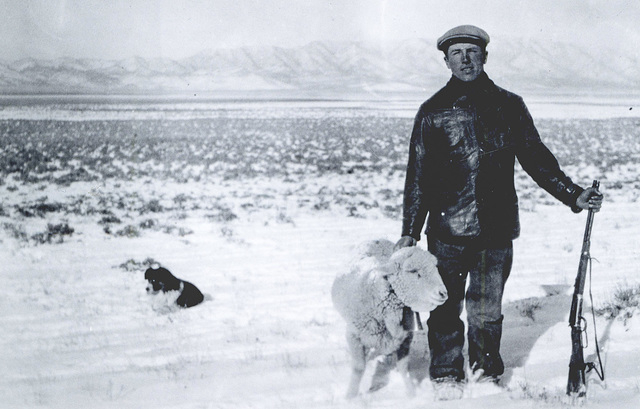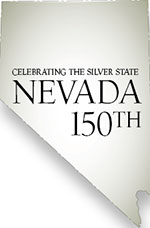Elko County: From ranching roots to streets paved with gold
Editor’s Note: Nevada 150 is a yearlong series highlighting the people, places and things that make up the history of the state.
You could fit all of Elko County’s residents inside a quarter of Summerlin.
But don’t let a population of just 49,000 fool you: This county — the fourth-largest in area in the lower 48 states — has left an out-sized imprint on American commerce and culture. It holds in its hands the fates of Fortune 500 companies. It sets the atmosphere in movies and novels. It inspires short stories from great American journalists. It even got one of America’s biggest movie stars to let his hair down — literally.
To understand how Elko County has captured so many imaginations, start with its history.
The first white settlers moved into the area in 1864 and began ranching in Lamoille Valley at the foot of the Ruby Mountains. Ranchers flocked to the valley from across Europe. But it was the Basques, an ethnic group whose homeland straddles the border of France and Spain, who leapt at the opportunity to populate the nascent state’s northeast. There, they raised sheep and sold meat to workers inside the region’s flourishing silver mines.
Ranching is no longer Elko County’s top industry — we’ll get to its modern-day No. 1 in a minute — but visit the city of Elko, and you’ll still see the Basque population’s influence. It’s reflected particularly in Elko’s abundant Basque restaurants, with their lamb chops smothered in garlic and their shots of picon punch, a cocktail of grenadine, club soda, brandy and Amer Picon that has laid flat more than its share of cowboys and miners. There’s even an annual running of the bulls, part of the city’s 50-year-old National Basque Festival.
More broadly, the county celebrates its ranching heritage with the annual National Cowboy Poetry Gathering, a January confab that hosts as many as 8,000 visitors a year. The event drew former U.S. Supreme Court Justice Sandra Day O’Connor as a keynote speaker in 2009. It also got national attention in 2011, after Senate Majority Leader Harry Reid found himself defending federal funding for the program.
But in the end, it wasn’t ranchers who made Elko County. Rather, it was a railroad.
When the Central Pacific Railroad began passing through in 1868, the towns of Elko, Carlin and Wells were established. A year later, the state Legislature created Elko County, making Elko its county seat and naming it after the berg. No one really knows where the name came from. But historian Howard Hickson, director emeritus of Elko’s Northeastern Nevada Museum, offers what most observers believe is the likeliest explanation: Central Pacific Superintendent Charles Crocker liked animal names. He settled on “elk” with that “o” tacked onto the end.
Ranching remained a key part of Elko County’s economy until the 1960s, when a California geologist discovered microscopic gold in its countryside. That eureka moment helped miners uncover the Carlin trend, one of the world’s premier gold deposits. That 5-mile-wide ore body extends 50 miles from Elko County to Eureka County, and it makes Nevada the world’s fifth-largest gold producer after Australia, South Africa, China and Russia.
The world’s two biggest gold miners, Barrick Gold Corp. and Newmont Mining Corp., get big chunks of their output from mines in Elko County. And that’s not going to change anytime soon: Barrick continues to explore new fields on the Carlin trend, and Newmont’s Long Canyon trend east of Elko looks promising as well.
Still, gold isn’t the only thing that has glittered in Elko County.
The county has rubbed elbows with Hollywood stars and had roles in hit movies and best-selling novels.
The county’s biggest association with celebrities began in the late 1940s, when singer and actor Bing Crosby began buying up ranches in the area and spending summers there. He frequented the city of Elko, where “he was treated just like one of the locals,” Hickson wrote in a history of the area.
Crosby got so comfortable in Elko that he even let photographers take a snapshot of him sans hairpiece in 1948, accepting a key to the city as its honorary mayor. Crosby remained Elko’s honorary mayor until his death in 1977.
About a decade later, horror writer Dean Koontz set big chunks of his 1986 novel “Strangers” in Elko County.
Journalist and author Hunter S. Thompson featured the eponymous county seat in “Fear and Loathing in Elko,” a short story in Rolling Stone magazine’s January 1992 issue.
And Bill Murray’s Phil the Weatherman said at the beginning of 1993’s “Groundhog Day” that Elko is the one place he’d be if he could choose.
There are roughly 49,000 people up north who probably agree.
Contact Jennifer Robison at jrobison@reviewjournal.com. Follow @J_Robison1 on Twitter.




















